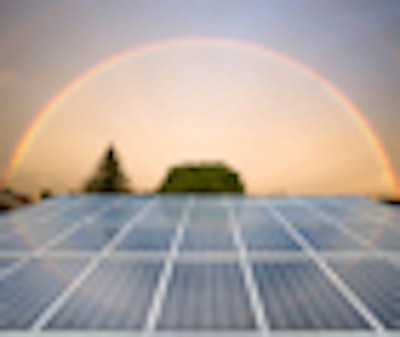
When Ronald Perry, D.M.D., got tired of paying his monthly electric bill, he decided to take matters into his own hands.
Now he generates his own electricity via solar panels mounted on the roof of his practice in Weymouth, MA.
"With energy prices on the rise, solar in general is a growing trend," explained Philip Hall, marketing executive at Borrego Solar Systems, a company that specializes in solar electric systems. "Small businesses like dentists have equipment that generates high electric bills. So, naturally, it makes sense for them to use clean solar energy to offset that usage."
“As long as the sun shines, I am getting free energy.”
— Ronald Perry, D.M.D., Weymouth, MA
Dr. Perry started looking into solar energy two years ago. He initially planned to install a solar electric system at his home, but trees around the property made it impractical. The new system at his office comprises 300 sq ft of solar panels and cost $35,000 to install. It will power 2,200 sq ft of the 4,900-sq-ft building, which he owns.
While the initial cost may seem high, he will receive a 40% rebate from the state to help offset this. In addition, any excess energy produced by the solar system will go back into the grid, and he will get credit from the local energy company.
Installation is simple. An energy consultant takes measurements with a Solmetric device in several locations and determines the best location for the solar array. Panels are then placed on the roof, or the installer does a ground mount if a large open space is near the property. Businesses can either stay on the grid or install a standalone solar system.
"As long as the sun shines, I am getting free energy," Dr. Perry said cheerfully. "It will keep my overhead down and help my patients."
The system has not been installed long enough for him to estimate his monthly savings so far, but he expects the technology to pay for itself within five to 10 years.
Savings on the monthly bill can vary. Depending on the level of electricity usage, some practices might eliminate their electric bill completely, Hall explained.
The bigger the system, the more expensive it is to install. Businesses can make a choice about the size that would suit them best and help them save the most money.
"Sometimes, it makes sense not to put a solar system on someone's property with the intent to zero out the bill, but rather to put just enough panels in to bring the meter into a lowered tier rate system," Hall said. "So the savings can be greater."
Even if the energy bill does not zero out, Robert Norris, D.D.S., said "going solar" will save him $500 a month on the energy bill at his San Antonio practice. His recently installed $100,000 solar electric system will cut the monthly bill down to $200 from $700, he said.
|
Solar energy resources Looking to go solar? Check out these helpful sites. Interstate Renewable Energy Council |
In addition, his current energy provider (CPS Energy) is giving him a 45% rebate on the system, bringing the total cost down to $55,000. He will get credit for any excess electricity that he produces, and when the solar system is unable to produce enough energy for his use, it will switch back to his regular energy provider.
The system will pay for itself in nine years and is guaranteed for 25 years, Dr. Norris said.
Businesses also save money because of the 30% federal tax credit for commercial properties that run on solar energy. And states offer varying degrees of incentives as well. For example, California currently offers a $1.90 per watt rebate.
"A 4 kW system is 4,000 watts. That's almost another $8,000 off the cost of the system," Hall said.
Hall considers a solar energy system a long-term investment as well. There is a value to the system that will transfer to a new property owner when the deed changes hands, for example. And even though they generally pay for themselves in eight to 10 years, the cost can be recovered at any time by selling the system.
"Statistically, it has been found that any improvement that will reduce utility bills by a single dollar annually will add $20 to the value of the property," Hall said. "Someone with a $100 per month electric bill spends $1,200 a year; if the solar system zeroes that out, that's $24,000 added to the [value of the] property."
It is numbers like these that sold the technology to Dr. Norris and Dr. Perry, who believe in clean, renewable energy -- especially when it helps with the bottom line.
"I invested in a solar electric system because it is green energy and we live in a very sunny place," Dr. Norris said. "It makes sense to harvest the sun's energy. But I just didn't want to be green. It had to make financial sense!"



















